


Including:
John Gower,
John Lydgate
and Guillaume
de Machaut

GEOFFREY CHAUCER c1340 -
xxxxxBorn in London, Geoffrey Chaucer began his working life in royal service and quickly rose to high office in the "civil service". He took part in a number of diplomatic missions to the continent, and in 1374 was appointed Controller of Customs at the Port of London. It was about this time that he began to make his name as a poet and storyteller. As a writer he is best known, of course, for his Canterbury Tales, begun in about 1387. By way of a well-
xxxxxThe English poet Geoffrey Chaucer was born in London, the son of a wine merchant. His father, who also acted as deputy to the king’s butler, secured him a post as a page in the household of Lionel, Duke of Clarence, one of the sons of Edward III. Intelligent, trustworthy and hardworking, he quickly made his mark. He served for a time in the French wars, and on being taken prisoner at the siege of Rheims in 1359, his ransom was paid in part by the king.
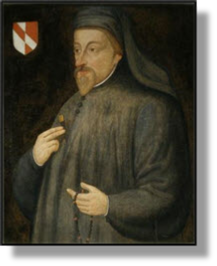 xxxxxHe then returned to the king’s service and, in 1366, married a noblewoman, an acquaintance and later relative of John of Gaunt, and this doubtless advanced his career. Under the patronage of the king’s brother, he quickly rose to high office in what we would now call the civil service. He travelled widely on behalf of the Crown, taking part in diplomatic missions to France, Spain and Italy and -
xxxxxHe then returned to the king’s service and, in 1366, married a noblewoman, an acquaintance and later relative of John of Gaunt, and this doubtless advanced his career. Under the patronage of the king’s brother, he quickly rose to high office in what we would now call the civil service. He travelled widely on behalf of the Crown, taking part in diplomatic missions to France, Spain and Italy and -
xxxxxIn 1385 he appears to have moved to Greenwich, possibly prompted by the emergence of a baronial party hostile to the king and his benefactor John of Gaunt. However, such was his standing here that he was promptly appointed a justice of the peace for Kent and, in 1386, became a knight of the shire, able to take his place as a member of parliament. His final post in public service came In 1389 when Richard II, now back in command, made him clerk of the king’s works, overseeing the repair and maintenance of such royal buildings as Westminster Palace and the Tower of London.
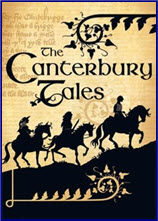
xxxxxIn 1391, as a step towards full retirement, he accepted the position of deputy forester in the king’s park at North Petherton in Somerset. It was during this period that he became a close friend of the Earl of Derby, the son of John of Gaunt and the future king Henry IV. A year before his death he came back to London and lived in a house in the garden of Westminster Abbey. It was here that he died in 1400. He was buried in the Abbey, his tomb being the first to be placed in the area now known as Poets’ Corner. His wife had died in 1387, and he left two sons and two daughters.
xxxxxChaucer lived such a full and busy life as courtier, diplomat and servant of the Crown that it is difficult to see how he found time to write, but he certainly did. His major work and the one by which he will be forever remembered, of course, is The Canterbury Tales, probably begun around 1387. In the format of a frame story (like Boccaccio’s Decameron), the work tells of thirty one pilgrims (including the author) who assemble at the Tabard Inn in Southwark -
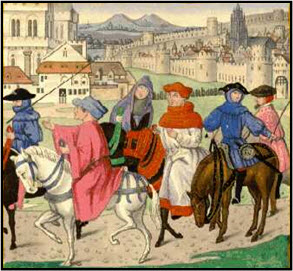
xxxxxThe colourful characters who make up this jovial party are chosen from all walks of life and are skilfully drawn. They provide a kaleidoscope of human emotions and a fascinating insight into human nature in the raw, its failures, triumphs, joys and sorrows. The characters range from the humble ploughman and carpenter to the lawyer and “the parfit, gentil knight”; the themes cover a wide span, such as marriage, sex, religion, hypocrisy and various aspects of love; and the order of the tales is so arranged as to make the most out of the interaction between the differing personalities and the diversity of their views.
xxxxxHowever, as entertaining as the tales are by such a varied cast -
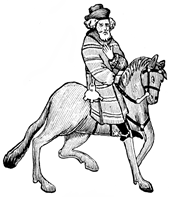 xxxxxThroughout the telling of the tales runs the author’s humanity, good humour and wit -
xxxxxThroughout the telling of the tales runs the author’s humanity, good humour and wit -
xxxxxAmong other works written by Chaucer is his Book of the Duchess, an allegorical dream-
xxxxxHis work in the vernacular had a profound influence on the development of English literature, both in the range of its poetic meters and the skill of its narrative. As we shall see, Shakespeare and the Elizabethan dramatists in particular owe much to his mastery of the language and his astute observation of society. He has rightly been seen as ushering in the dawn of the English renaissance. It is just a pity that, given the social turmoil into which England was thrown over the next eighty years or so, the sun took a little time to rise!
xxxxxIncidentally, the name Chaucer comes from the French word chaussier meaning shoe-
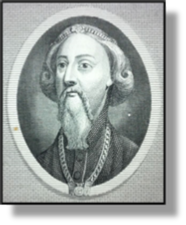 xxxxxTwo English poets, contemporaries and friends of Chaucer, deserve a mention. John Gower (1330-
xxxxxTwo English poets, contemporaries and friends of Chaucer, deserve a mention. John Gower (1330-
xxxxxJohn Lydgate (c1370-
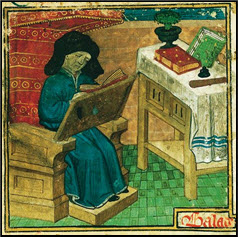 xxxxxFor his work The Book of the Duchesse, Chaucer leaned heavily upon the poetry of the French poet and musician Guillaume de Machaut (c1300-
xxxxxFor his work The Book of the Duchesse, Chaucer leaned heavily upon the poetry of the French poet and musician Guillaume de Machaut (c1300-
xxxxxHe was born at Machaut in Champagne in about 1300 and, as a young man, served in the household of King John of Bohemia. He accompanied the king on military expeditions, and enjoyed a life of adventure. In about 1337 he was appointed a canon of Rheims, and he remained there until his death in 1377. Well known and admired at court, his patrons included the king’s daughter, Bonne of Luxembourg, and King Charles V of France.



Acknowledgements
Chaucer: 17th century portrait, artist unknown – UK Government Art Collection, London. Canterbury Tales: detail of manuscript at the beginning of the Prologue, probably by the Flemish miniaturist Gerard Horenbout (c1465-
R2-